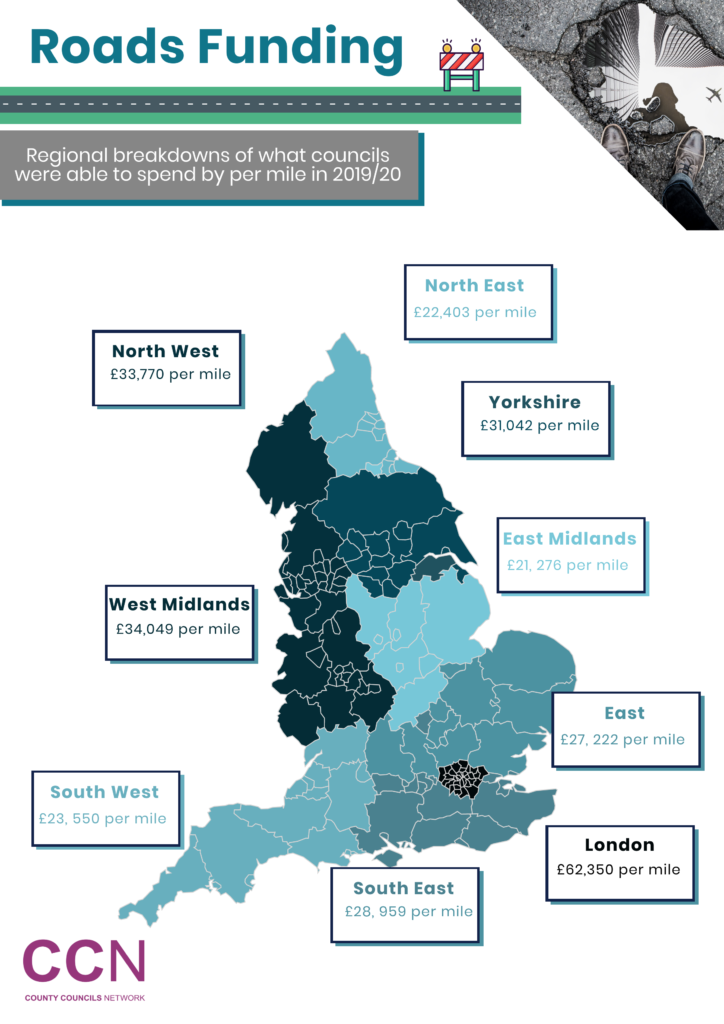
CCN Latest News, CCN News 2020 | 13 January 2020

The County Councils Network (CCN), which has produced the research, says that lower funding for shire counties and regional investment being disproportionately skewed towards urban areas has left motorists in their areas ‘poor relations’ to those in the major cities. Leaders of England’s county authorities are calling for a fair share of the government’s new £2bn pothole fund and a long-term commitment to ‘level up’ investment.
The figures show that the 36 shire counties in the analysis were able to spend £20,885 per mile on road repairs, pothole filling, and constructing new junctions and networks last year. In contrast, the 31 councils in London are able to spend £62,350 per mile. The 36 urban metropolitan councils spent £41,929 per mile, while England’s eight ‘core cities’ are in a position to invest £57,241 per mile.
The analysis was featured in today’s Telegraph and Yorkshire Post.
Regionally, the analysis shows that councils in London plan to spend double the amount of almost every single region in England. Per mile expenditure is lowest in the East Midlands (£21,276), followed by the North East (£22,403) and the South West (£23,550). Even regions with higher planned investment, such as the West Midlands (£34,049) and North West (£33,770), have a per mile expenditure that is 45% lower than the capital. Download an infographic on regional expenditure here.
County leaders say that they know it is vital their local roads are kept in a good condition, but lack the funding required to carry out complete repairs, whilst the capital and other major cities benefit from more generous funding for more comprehensive pothole filling and anti-congestion schemes.
In total, 11,117 miles of road network in shire counties were identified as requiring maintenance last year – this is 9% of the total mileage in counties and over fifteen times higher, in terms of mileage, than the figure in London. In the capital, 730 miles, or 8% of the total mileage, require repair at some point in the future, and in other urban authorities the figure is 6% or 1,537 miles. Download an infographic on council type variations in spend here.
Below, watch regional coverage of the analysis which has been featured on BBC local news this afternoon.
The new government has pledged to make available £2bn for filling potholes over the next four years, which was outlined in the Conservative manifesto and amounts to £500m per year. This comes as part of its commitment to ‘level up’ infrastructure investment across the country.
The pothole fund builds on a one-off £420m fund made available to councils in the 2018 Budget. A snap poll of 24 shire counties shows that those authorities used that money to address defects and potholes on over 2,200 roads within the first six months of last year.
An announcement on the allocations of the £500m capital pothole funding for 2020/21 is expected in the coming weeks, with county leaders arguing that the government must allocate the resources in the same manner as the 2018/19 fund. Shire counties received 74% of total funding.
However, despite this, CCN’s latest analysis shows that investment still lags behind all other councils’ types. CCN is also calling for the government to ensure that their commitment to ‘level up’ investment across the country includes making the allocation of funding for local roads more equitable, setting out long term funding for roads maintenance, and ensures that their areas also benefit from the promise to level up regional infrastructure investment.
The figures are both day-to-day revenue expenditure and capital investment and include routine maintenance, filling potholes, resurfacing, new road infrastructure, streetlight repairs, drainage cleaning and ensuring that roads are in good condition over the winter. They exclude further investment by regional authorities that cover major cities, such as the Greater London Authority and Mayoral Combined Authorities.
 Cllr David Williams, County Councils Network chairman, said:
Cllr David Williams, County Councils Network chairman, said:
“The scourge of potholes and gridlocked roads are amongst the biggest local issues council leaders find in their mailboxes every week, affecting motorists, cyclists and local businesses alike. We know how important it is to keep our roads in a good condition, and we do our utmost to fill defects, upgrade routes and invest in new infrastructure despite the challenging financial circumstances faced by councils.
“But today’s analysis shows that county motorists are clearly the poor relation to drivers in London and other cities areas when it comes to how much gets spent on fixing potholes and improving the local road network, with drivers across the country facing a pothole lottery, even within regions. Due to more generous day-to-day funding and infrastructure investment, cities and urban areas are in a position to spend disproportionate amounts in keeping their roads maintained or upgraded compared to councils in counties. This is despite far more of our road network in the shires requiring repairs and improvements.
“The government’s £2bn pothole fund and commitment to level up infrastructure are therefore extremely welcome. These findings show that it is imperative our areas receive a fair share of the government’s new fund, in proportion to the number of miles we are responsible for, while ensuring the longer-term commitment to level up funding for national infrastructure doesn’t bypass county areas that stretch across the length and breadth of England and are the vital arteries for those ‘left-behind’ towns.
“County local authorities showed themselves able to spend the pothole money made available in the 2018 Budget quickly with significant results – repairing well over 2,000 roads. Should we receive a similar proportion of funds from this tranche of money, we will endeavour to do even more for our motorists.”
 Cllr Stephen Giles-Medhurst, County Councils Network spokesperson for transport and infrastructure, said:
Cllr Stephen Giles-Medhurst, County Councils Network spokesperson for transport and infrastructure, said:
“Today’s analysis shows that there are huge disparities in what the regions receive for roads, pothole filling, and anti-congestion measures compared to London and the major cities.
“With over 11,000 miles in county areas identified as requiring repairs, the government should back up its rhetoric in ‘levelling up’ the country and distribute a fairer share of funding for roads in rural areas in its upcoming funding announcements.”

Notes to editor
| Council type | Total Expenditure | Miles Maintained | Per Mile Expenditure |
| Shire counties (36) | £2,638,019,574 | 126,492 | £20,855 |
| Metropolitan authorities (44) | £1,080,761,897 | 25,776 | £41,929 |
| London boroughs (31*) | £569,103,240 | 9,128 | £62,350 |
| English unitary authorities (44**) | £1,161,353,324 | 21,895 | £53,041 |
| Core Cities (8) | £468,338,356 | 8,182 | £57,241 |
*City of London excluded
** Bournemouth, Christchurch & Poole, and Isle of Scilly excluded
| Regions | Total Expenditure | Total Miles | Total Per Mile Expenditure | |
| East Midlands | £408,590,641 | 19,205 | £21,276 | |
| North East | £222,169,782 | 9,917 | £22,403 | |
| South West | £697,253,582 | 29,607 | £23,550 | |
| East | £658,751,080 | 24,199 | £27,222 | |
| South East | £844,055,720 | 29,146 | £28,959 | |
| Yorkshire & Humber | £603,890,461 | 19,454 | £31,042 | |
| North West | £761,342,372 | 22,545 | £33,770 | |
| West Midlands | £684,081,157 | 20,091 | £34,049 | |
| London | £569,103,240 | 9,128 | £62,350 | |
© 2024 County Councils Network | Credits | Site map | Cookies | Privacy Policy.